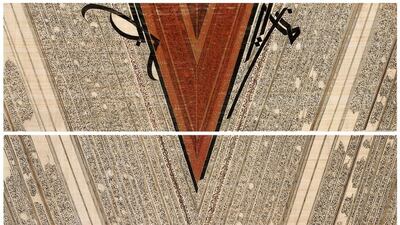The Yesterday Is Tomorrow's Memory exhibition in Dubai's Elmarsa Gallery offers visitors an engaging history lesson as well as a spectacular visual treat.
It presents a cross-section of key works by major artists who have played an important role in the history of modern and contemporary art from the Maghreb region – or more specifically, Tunisia, Algeria and Morocco.
The show features the work of 23 artists, effectively pooling the best Elmarsa has to offer.
The studio, which opened in Dubai in November, was founded in 1994 in Tunis and has developed an impressive stable of artists. This exhibition affords an opportunity to showcase the length and breadth of the collections.
The ground floor covers mostly contemporary work from the past few years. Standout pieces include Omar Bey’s Once Upon a Time (2016), in which the artist – who uses a variety of media to express his often politically charged statements – depicts a woodpecker drilling holes into graphically stylised skulls to evoke the absurdity of the modern condition.
At 35, Atef Maatallah is the youngest artist in the exhibition.
On show are two pieces from his series Automne – oil portraits of subjects with dazed, deadened eyes that suggest a detachment from reality, a reference to the sense of loss and confusion experienced by young people in the region.
A personal favourite is Meriem Bouderbala’s intriguing Bedouinas III (2013). The Tunisian-born, Paris-based artist has used mother-of-pearl dust and sand to cover a voluminous piece of cloth, which was once a traditional dress. From a distance its shape takes on the figure of a woman; close up, the details are captivating.
Upstairs in the gallery, however, are perhaps the true stars of the show – artworks from the 1960s by some of the most lauded artists from the region.
Rachid Koraïchi’s sculpture Les Priants casts its shadow across the floor, and the simply stunning Abstraction Numéro 45 (1964) by Néjib Belkhodja echoes the shapes and lines of the region’s architecture.
On the central wall, Baya’s Jeune Musicienne is worth pondering. Baya was an untrained Algerian artist who worked with Pablo Picasso in France and had a similar ability to evoke a childlike spirit in her technically skilled creations.
The far corner of the upper floor is dedicated to Hurufiyya, an artistic movement that takes the Arabic script as its base but adapts it to suit the artist’s style.
Here, Tunisian Khaled Ben Slimane’s beautifully executed ceramic pieces are displayed alongside Nja Mahdaoui’s instantly recognisable calligraphy pieces and Le Main by Moroccan artist Farid Belkahia – made from a leather-like material and carved into the shape of the hand of Fatima.
Put together by the gallery’s co-director, Lilia Ben Salah, this exhibition will run throughout the summer.
It is the gallery’s overall aim, says Ben Salah, to look to the future, while at the same time embracing the past.
“The selection of cross-generational artists signifies the rich contemporary art scene in the region, as well as renewed interests in modern art,” she says.
“As a result, our inventory of works reflects the gallery’s commitment to creating a synergy between diverse cultures through artistic expression and historical context.”
• Yesterday Is Tomorrow’s Memory runs until July 30. Visit www.galerielmarsa.com
aseaman@thenational.ae

